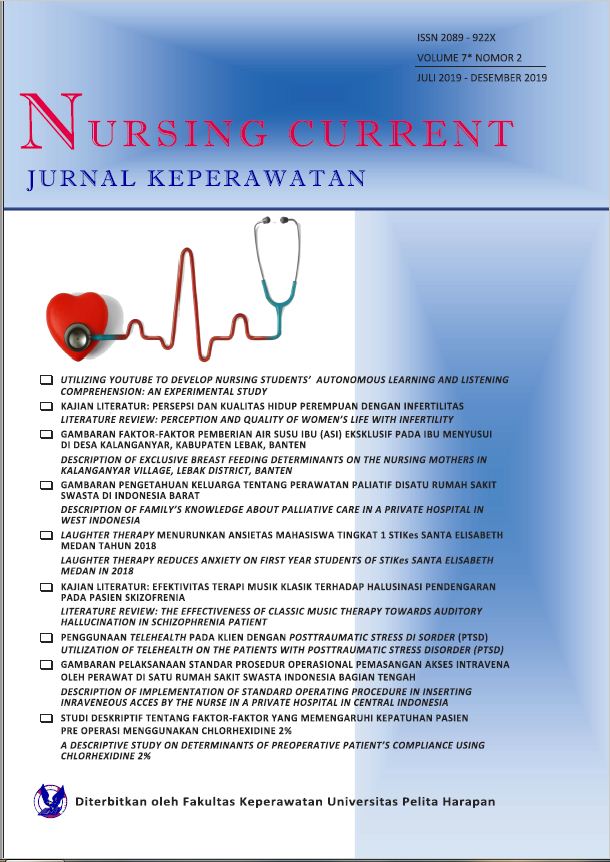UTILIZING YOUTUBE TO DEVELOP NURSING STUDENTS’ AUTONOMOUS LEARNING AND LISTENING COMPREHENSION: AN EXPERIMENTAL STUDY
DOI:
https://doi.org/10.19166/nc.v7i2.2278Trefwoorden:
Autonomous learning, Experimental Study, Listening Comprehension, YouTubeSamenvatting
Industrial Revolution (IR) 4.0. is about dealing with digital-native students and developing autonomous learning. One possible strategy to deal with these issues is using YouTube as a tool for English language learning. There have been some studies discussing the effectiveness of using it, yet we still have niches; for instance, deeper and wider contexts and respondents. Thus, this study aims to examine students’ autonomy over their learning and whether YouTube can develop the listening comprehension skills of nursing students in a Faculty of Nursing in Tangerang. To achieve the first aim, quantitative and qualitative studies were conducted, while for the second aim, an experimental study was used. The experimental study involved an experimental group consisting of 16 students and a control group consisting of 16 students. The result shows that the participants consider YouTube as a useful support to develop their autonomy in learning English and YouTube video has been successful to develop their listening skills.
Referenties
Alqahtani, E. T. (2014). Effectiveness of Using YouTube on Enhancing EFL Students' Listening Comprehension Skills. Doctoral dissertation, Islamic University.
Alwehaibi, H. O. (2015). The Impact Of Using YouTube In EFL Classroom On Enhancing EFL Students' Content Learning. Journal of College Teaching & Learning (TLC), 12(2), 121-126. https://doi.org/10.19030/tlc.v12i2.9182
Angraini, N. E. (2015). The use of YouTube videos with retelling technique to improve speaking and writing achievement. The 62nd TEFLIN International Conference (pp. 50-61). Sanur, Indonesia: Udayana University.
Brook, J. (2011). The affordances of YouTube for language learning and teaching. Hawaii Pacific University TESOL Working Paper Series, 9(1), 2. Retrieved from https://www.hpu.edu/research-publications/tesol-working-papers/2011/9_1-2_Brook.pdf
Dickinson, L. (1995). Autonomy and motivation: A literature review. System, 165-174. https://doi.org/10.1016/0346-251X(95)00005-5
Drath, R., & Horch, A. (2014). Industrie 4.0: Hit or hype? IEEE Industrial Electronics Magazine, 8(2), 56-58. https://doi.org/10.1109/MIE.2014.2312079
Han, Y. J. (2015). Successfully flipping the ESL classroom for learner autonomy. NYS TESOL Journal, 2(1), 98-10.
Holec, H. (1981). Autonomy and foreign language learning. Oxford: Pergamon for the Council of Europe.
Jalaluddin, M. (2016). Using YouTube to enhance speaking skills in ESL classroom. English for Specific Purposes World, 17, 50.
Kourieos, S., & Evripidou, D. (2013). Students’ perceptions of effective EFL teachers in university settings in Cyprus. English Language Teaching, 6(11). https://doi.org/10.5539/elt.v6n11p1
Littlewood, W. (1996). "Autonomy": An anatomy and a framework. System, 427-435. https://doi.org/10.1016/S0346-251X(96)00039-5
Paltridge, B., & Phakiti, A. (2015). Research methods in applied linguistics: A practical resource. London: Bloomsbury Publishing.
Paramita, H., & Recard, M. (2017). Students’ autonomy in utilizing social media. 7th MELTA International Research Conference in English Language Education 2017. Kuala Lumpur, Malaysia: MELTA.
Sanprasert, N. (2010). The application of a course management system to enhance autonomy in learning English as a foreign language. System, 38(1), 109-123. https://doi.org/10.1016/j.system.2009.12.010
Shao-yue, W. (2009). A study of network-based multimedia college English. US-China Foreign Language, 38-55.
Snelson, C. (2011). YouTube across the disciplines: A review of the literature. MERLOT Journal of Online Learning and Teaching, 7(1), 159-69. Retrieved from https://jolt.merlot.org/vol7no1/snelson_0311.pdf
Sommers, C. (2018). English admission exam scores for ETP 2017. Tangerang, Indonesia.
Vygotsky, L. S. (1981). The genesis of higher mental functions. In J. V. Wertsch (Ed.), The concept of activity in Soviet psychology. Armonk, NY: Sharpe.
Watkins, J., & Wilkins, M. (2011). Using YouTube in the EFL classroom. Language Education in Asia, 2(1) 113-119. https://doi.org/10.5746/LEiA/11/V2/I1/A09/Watkins_Wilkins
Zafar, S. (2016). Use of social network sites for teaching and managing knowledge in adult education. English for Specific Purposes World, 17(49) 1-20.
##submission.downloads##
Gepubliceerd
Citeerhulp
Nummer
Sectie
Licentie
Authors who publish with this journal agree to the following terms:
1) Authors retain copyright and grant the journal right of first publication with the work simultaneously licensed under a Creative Commons Attribution License (CC-BY-SA 4.0) that allows others to share the work with an acknowledgement of the work's authorship and initial publication in this journal.
2) Authors are able to enter into separate, additional contractual arrangements for the non-exclusive distribution of the journal's published version of the work (e.g., post it to an institutional repository or publish it in a book), with an acknowledgement of its initial publication in this journal.
3) Authors are permitted and encouraged to post their work online (e.g., in institutional repositories or on their website). The final published PDF should be used and bibliographic details that credit the publication in this journal should be included.

This work is licensed under a Creative Commons Attribution-ShareAlike 4.0 International License.






